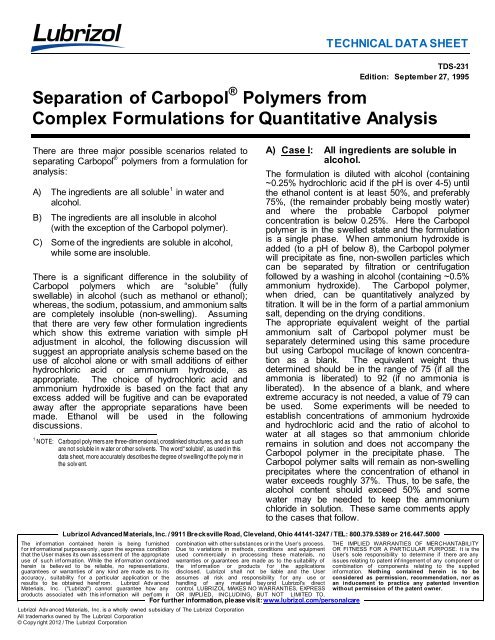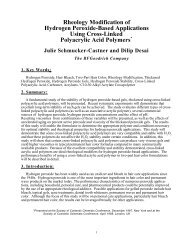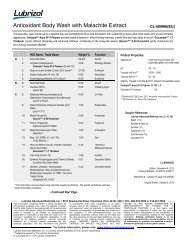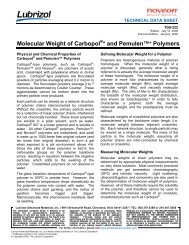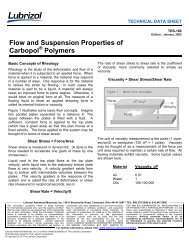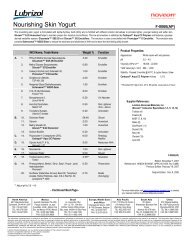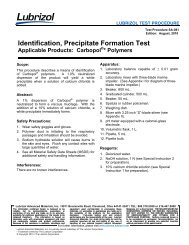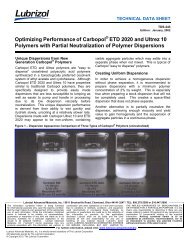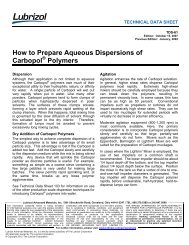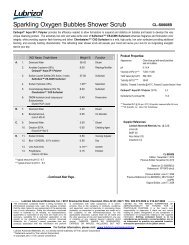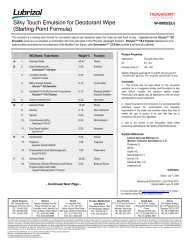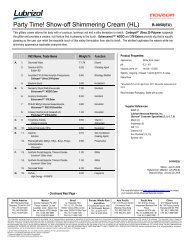TDS-231 Separation of Carbopol® Polymers from ... - Lubrizol
TDS-231 Separation of Carbopol® Polymers from ... - Lubrizol
TDS-231 Separation of Carbopol® Polymers from ... - Lubrizol
Create successful ePaper yourself
Turn your PDF publications into a flip-book with our unique Google optimized e-Paper software.
TECHNICAL DATA SHEET<br />
<strong>TDS</strong>-<strong>231</strong><br />
Edition: September 27, 1995<br />
<strong>Separation</strong> <strong>of</strong> Carbopol ® <strong>Polymers</strong> <strong>from</strong><br />
Complex Formulations for Quantitative Analysis<br />
There are three major possible scenarios related to<br />
separating Carbopol ® polymers <strong>from</strong> a formulation for<br />
analysis:<br />
A) The ingredients are all soluble 1 in water and<br />
alcohol.<br />
B) The ingredients are all insoluble in alcohol<br />
(with the exception <strong>of</strong> the Carbopol polymer).<br />
C) Some <strong>of</strong> the ingredients are soluble in alcohol,<br />
while some are insoluble.<br />
There is a significant difference in the solubility <strong>of</strong><br />
Carbopol polymers which are “soluble” (fully<br />
swellable) in alcohol (such as methanol or ethanol);<br />
whereas, the sodium, potassium, and ammonium salts<br />
are completely insoluble (non-swelling). Assuming<br />
that there are very few other formulation ingredients<br />
which show this extreme variation with simple pH<br />
adjustment in alcohol, the following discussion will<br />
suggest an appropriate analysis scheme based on the<br />
use <strong>of</strong> alcohol alone or with small additions <strong>of</strong> either<br />
hydrochloric acid or ammonium hydroxide, as<br />
appropriate. The choice <strong>of</strong> hydrochloric acid and<br />
ammonium hydroxide is based on the fact that any<br />
excess added will be fugitive and can be evaporated<br />
away after the appropriate separations have been<br />
made. Ethanol will be used in the following<br />
discussions.<br />
1 NOTE: Carbopol poly mers are three-dimensional, crosslinked structures, and as such<br />
are not soluble in w ater or other solvents. The word “soluble”, as used in this<br />
data sheet, more accurately describes the degree <strong>of</strong> swelling <strong>of</strong> the poly mer in<br />
the solv ent.<br />
A) Case I: All ingredients are soluble in<br />
alcohol.<br />
The formulation is diluted with alcohol (containing<br />
~0.25% hydrochloric acid if the pH is over 4-5) until<br />
the ethanol content is at least 50%, and preferably<br />
75%, (the remainder probably being mostly water)<br />
and where the probable Carbopol polymer<br />
concentration is below 0.25%. Here the Carbopol<br />
polymer is in the swelled state and the formulation<br />
is a single phase. When ammonium hydroxide is<br />
added (to a pH <strong>of</strong> below 8), the Carbopol polymer<br />
will precipitate as fine, non-swollen particles which<br />
can be separated by filtration or centrifugation<br />
followed by a washing in alcohol (containing ~0.5%<br />
ammonium hydroxide). The Carbopol polymer,<br />
when dried, can be quantitatively analyzed by<br />
titration. It will be in the form <strong>of</strong> a partial ammonium<br />
salt, depending on the drying conditions.<br />
The appropriate equivalent weight <strong>of</strong> the partial<br />
ammonium salt <strong>of</strong> Carbopol polymer must be<br />
separately determined using this same procedure<br />
but using Carbopol mucilage <strong>of</strong> known concentration<br />
as a blank. The equivalent weight thus<br />
determined should be in the range <strong>of</strong> 75 (if all the<br />
ammonia is liberated) to 92 (if no ammonia is<br />
liberated). In the absence <strong>of</strong> a blank, and where<br />
extreme accuracy is not needed, a value <strong>of</strong> 79 can<br />
be used. Some experiments will be needed to<br />
establish concentrations <strong>of</strong> ammonium hydroxide<br />
and hydrochloric acid and the ratio <strong>of</strong> alcohol to<br />
water at all stages so that ammonium chloride<br />
remains in solution and does not accompany the<br />
Carbopol polymer in the precipitate phase. The<br />
Carbopol polymer salts will remain as non-swelling<br />
precipitates where the concentration <strong>of</strong> ethanol in<br />
water exceeds roughly 37%. Thus, to be safe, the<br />
alcohol content should exceed 50% and some<br />
water may be needed to keep the ammonium<br />
chloride in solution. These same comments apply<br />
to the cases that follow.<br />
<strong>Lubrizol</strong> Advanced Materials, Inc. / 9911 Brecksville Road, Cleveland, Ohio 44141-3247 / TEL: 800.379.5389 or 216.447.5000<br />
The inf ormation contained herein is being f urnished combination with other substances or in the User’s process.<br />
f or inf ormational purposes only , upon the express condition Due to v ariations in methods, conditions and equipment<br />
THE IMPLIED WARRANTIES OF MERCHANTABILITY<br />
OR FITNESS FOR A PARTICULAR PURPOSE. It is the<br />
that the User makes its own assessment <strong>of</strong> the appropriate used commercially in processing these materials, no User’s sole responsibility to determine if there are any<br />
use <strong>of</strong> such inf ormation. While the inf ormation contained warranties or guarantees are made as to the suitability <strong>of</strong> issues relating to patent inf ringement <strong>of</strong> any component or<br />
herein is believ ed to be reliable, no representations,<br />
guarantees or warranties <strong>of</strong> any kind are made as to its<br />
the inf ormation or products f or the applications combination <strong>of</strong> components relating to the supplied<br />
disclosed. <strong>Lubrizol</strong> shall not be liable and the User inf ormation. Nothing contained herein is to be<br />
accuracy , suitability f or a particular application or the assumes all risk and responsibility f or any use or considered as permission, recommendation, nor as<br />
results to be obtained heref rom. <strong>Lubrizol</strong> Adv anced handling <strong>of</strong> any material bey ond <strong>Lubrizol</strong>'s direct an inducement to practice any patented invention<br />
Materials, Inc. ("<strong>Lubrizol</strong>") cannot guarantee how any control. LUBRIZOL MAKES NO WARRANTIES, EXPRESS without permission <strong>of</strong> the patent owner.<br />
products associated with this inf ormation will perf orm in OR IMPLIED, INCLUDING, BUT NOT LIMITED TO,<br />
For further information, please visit: www.lubrizol.com/personalcare<br />
<strong>Lubrizol</strong> Adv anced Materials, Inc. is a wholly owned subsidiary <strong>of</strong> The <strong>Lubrizol</strong> Corporation<br />
All trademarks owned by The <strong>Lubrizol</strong> Corporation<br />
© Copy right 2012 / The <strong>Lubrizol</strong> Corporation
B) Case II: All ingredients (except<br />
Carbopol polymer) are alcohol<br />
insoluble.<br />
A large excess <strong>of</strong> alcohol is added to the<br />
formulation so that the Carbopol polymer<br />
concentration is less than 0.25% and the other<br />
ingredients are insoluble. To insure that the<br />
Carbopol polymer is fully swellable, the alcohol<br />
used contains about 0.25% hydrochloric acid. The<br />
insoluble formulation ingredients are separated out<br />
by filtration or centrifugation. The dilute solution is<br />
stirred while about 0.5% ammonium hydroxide is<br />
added to the system (addition as a water solution is<br />
permissible). The Carbopol polymer will precipitate<br />
as fine white particles that can be separated and<br />
treated as in Case I above.<br />
C) Case III: Some formulation ingredients<br />
are alcohol soluble while<br />
others are not.<br />
This situation may represent the majority <strong>of</strong> cases<br />
and will require an additional step. Here we assure<br />
that the Carbopol polymer is initially fully alcohol<br />
swellable by adding hydrochloric acid to reduce the<br />
pH below 3 and adding alcohol until 50% (or<br />
preferably 75%) concentration is reached and the<br />
concentration <strong>of</strong> Carbopol polymer is below 0.25%.<br />
The diluted formulation is then centrifuged or<br />
filtered to effect separation <strong>of</strong> the insoluble<br />
ingredients followed by washing, etc. The diluted<br />
solution phase (including the washing) contains<br />
alcohol soluble ingredients and swelled Carbopol<br />
polymer. It should then be treated by adding<br />
ammonium hydroxide to the system and<br />
proceeding as in Case I.<br />
<strong>TDS</strong>-<strong>231</strong><br />
<strong>Separation</strong> <strong>of</strong> Carbopol ® <strong>Polymers</strong> <strong>from</strong> Complex<br />
Formulations for Quantitative Analysis<br />
Page 2 <strong>of</strong> 3
<strong>TDS</strong>-<strong>231</strong><br />
<strong>Separation</strong> <strong>of</strong> Carbopol ® <strong>Polymers</strong> <strong>from</strong> Complex<br />
Formulations for Quantitative Analysis<br />
Page 3 <strong>of</strong> 3<br />
<strong>Separation</strong> <strong>of</strong> Carbopol ® <strong>Polymers</strong> <strong>from</strong> Complex<br />
Formulations for Quantitative Analysis (Flow Chart)<br />
Formulation Ingredients<br />
Soluble in water and alcohol Insoluble in alcohol*<br />
(*Note: Carbopol ® polymer is<br />
soluble)<br />
Dilute with excess alcohol<br />
(50-75%) (~pH 3-4)<br />
[Carbopol ® polymer<br />
concentration


